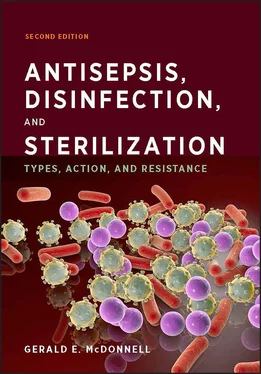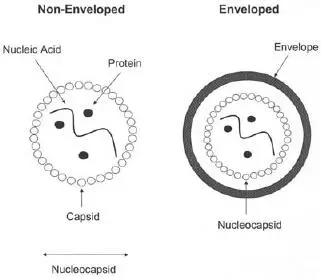
FIGURE 1.10 Basic viral structure.
Based on these basic viral structures, a variety of virus families which vary in shape and composition have been described. Examples of virus families are given in Table 1.13, but this list is not complete. For example, at least 20 families of viruses that are of medical importance and that vary in size, shape, and chemical composition have been identified; additional virus families have been described for plants, fungi, protozoa, and bacteria.
Viruses are dependent on host cells for survival and multiplication. Despite the range of viruses described, viral infection occurs in a similar series of steps: attachment, penetration, synthesis of biomolecules, assembly, and release ( Fig. 1.11). The first stage is attachment of the virus to the cell surface. This is mediated by specific proteins on the capsid or envelope surface that specifically interact with molecules on the cell surface known as receptors. Receptors can be cell membrane or cell wall proteins, lipids, carbohydrates, and even combinations of these. Therefore, the presence of specific receptors on the cell surface determines sensitivity or resistance to virus infection. Examples of receptors include the HIV receptor CD4 protein on the surfaces of human T cells and the binding of influenza virus to sialic acid, a carbohydrate linked to a cell membrane protein.
The next stage is penetration of the virus into the target cell, which can occur by different mechanisms. The nucleocapsid or nucleic acid, as the source genetic material that encodes the viral structure, can be injected or released into the cell. Similarly, the whole virus can be endocytosed into the cell or, in the case of enveloped viruses, by fusion with the cell membrane, which is subsequently uncoated to allow nucleic acid release. Endocytosis is typical for penetration of many vertebrate viruses. As mentioned above, some enzymes that are associated with the virus capsid are required for viral multiplication (e.g., reverse transcriptase in retroviruses, such as HIV) and are released into the target cell. In some viruses, the nucleic acid is modified (e.g., by methylation) to protect it from damage (by nucleases) when it is free in the cell. Once the cell is infected, the virus uses the available cell metabolic processes to replicate its nucleic acid and to allow the synthesis of specific viral proteins during the multiplication stage. Multiplication depends on the transcription and translation of viral mRNA. For DNA viruses, this can be achieved by the use of existing host enzymes, such as DNA-dependant RNA polymerases; in the case of RNA viruses, it may require specific viral proteins. An example already mentioned is the use of reverse transcriptase in retroviral multiplication, which generates DNA from a single-stranded RNA virus template. The viral proteins that are subsequently produced can be involved in the multiplication process (e.g., viral replication) or as structural parts of the virus. If viral multiplication continues, the cell will eventually burst or lyse to release the viral particles ( Fig. 1.11, step 4a); an example is poliovirus. Lysing, however, does not occur with all viruses. A further mechanism of virus release is budding from the cell surface, which produces a persistent infection in a cell. Examples include influenza virus and HIV; it should be noted that both of these are enveloped viruses and that the viral envelope is actually formed around the viral nucleocapsid during the budding release from the cell surface. Some viruses can remain dormant in their host cells; these are referred to as latent infections, which can reactivate at a later stage to cause disease. During dormancy, the virus may not affect the normal cellular functions. An example of a virus causing latent infection is the varicellazoster virus, which can remain dormant in neurons; varicella-zoster virus can cause chickenpox, commonly in children, and can reactivate to cause shingles, which is more prevalent in adults. In some cases, the presence of the virus may also trigger the uncontrolled growth of cells, leading to the development of cancers. Strong associations of viruses with cancers include papillomaviruses with skin and cervical cancers and some herpesviruses with lymphomas and carcinomas.
TABLE 1.13 Viral families, with examples of classifications, including size, presence of a lipophilic envelope, and nucleic acid type
| Viral family |
Structure |
Size (nm) |
Envelope |
Nucleic acid |
Example(s) |
| Parvoviridae |
 |
18–26 |
No |
DNA |
Mouse parvovirus, parvovirus B 19 |
| Flaviviridae |
 |
40–50 |
Yes |
RNA |
Ebola virus, Marburg virus |
| Adenoviridae |
 |
70–90 |
No |
DNA |
Adenovirus serotypes |
| Retroviridae |
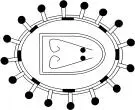 |
90–120 |
Yes |
RNA |
HIV type 1 |
| Herpesviridae |
 |
180–200 |
Yes |
RNA |
Epstein-Barr virus, herpes simplex virus |
| Poxviridae |
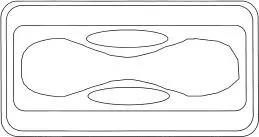 |
250–400 |
Yes |
DNA |
Monkeypox virus, variola (smallpox) virus |
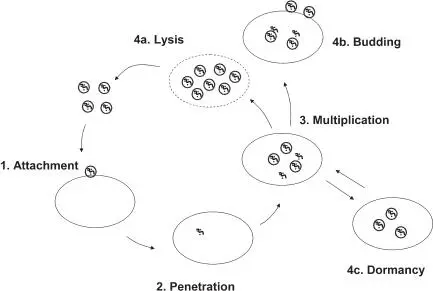
FIGURE 1.11 Typical viral life cycle. The stages include (1) attachment, (2) penetration into the cell, and (3) multiplication. Depending on the virus type, viral particles can be released by cell lysis (4a) or by budding (4b); alternatively, the virus can remain dormant in the cell (4c).
Viruses have been identified as the causes of a variety of plant, human, and animal diseases, including respiratory, sexually transmitted, neurological, and dermatological diseases ( Table 1.14). The traditional difficulty of isolation and identification of viruses limits their study; however, it is thought that many more viruses remain to be identified and implicated in diseases by developing molecular biology and electron microscopy techniques.
Separate families of plant viruses have also been described, including tobamoviruses (nonenveloped RNA viruses; e.g., tomato-tobacco mosaic virus is a significant agricultural and horticultural concern, because it infects vegetables, flowers, and weeds, leading to leaf, flower, and fruit damage), Comoviridae (nonenveloped RNA viruses), and Geminiviridae (nonenveloped DNA viruses). Viruses that infect fungi (e.g., the nonenveloped RNA viruses barnavirus and chryovirus) and bacteria (bacteriophages) ( Fig. 1.12) have also been described.
Читать дальше
